Pushing Ice
Graham Harbour, Thursday August 7, 2014 (74o 30.355’N, 88o 08.973’W):
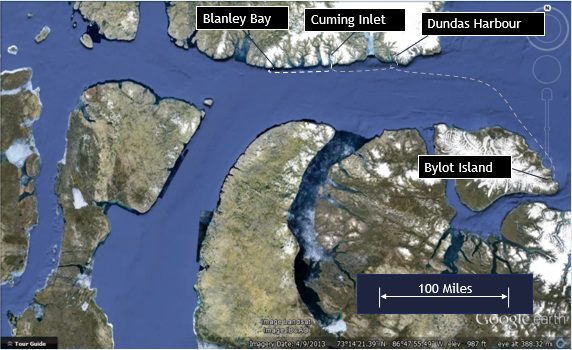
The crew threatened mutiny at the suggestion that re-anchoring in Blanley Bay (74o28.6’N / 87o20.4’W) might be an option. Two days earlier we had left Cuming Inlet, with its musk ox and walruses, to head further west down the coast of Devon Island, with the intent to put us in a better position to reach Resolute. The ice charts indicated the harbors and coastline along the route as green, corresponding to one to three tenths coverage of ice. Ice charts for the arctic are published once a day (http://www.ec.gc.ca/glaces-ice), providing flooded contours indicating the degree of coverage and type of ice. Blue indicates less than a tenth coverage, green is 1-3 tenths, yellow 4-6, orange 7-8, red 9-10, and gray is fixed ice.
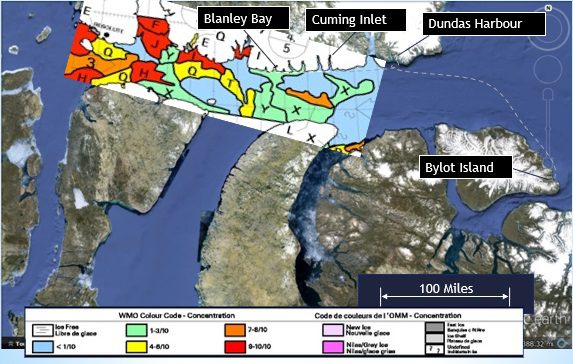
We all agreed that any region showing greater than a green 3/10th was to be avoided, while expecting that at some point in our passage we would have to negotiate a green zone. After discussing whether to wait for the afternoon ice report to see if the coastline had opened up, we decided to head back out the inlet and then down the coast to get a firsthand look at the conditions, while keeping our option open to retreat to Cuming or any open harbor along the way. As we left Cuming, the ice we’d seen the night before had thinned out and was easily passed. This was our first encounter with moving through pack ice and we were excited to the point of pulling out cameras. Heading westward, the regions along the coast, last reported as green, were now ice free and the inlets of Powell, Burnett, and Stratton all appeared to be open. Encouraged, we decided to push forward to Graham Harbour, an additional 35 miles to the west. Four hours later, I sent out a position report to the yachts Arctic Tern and Suilven, telling them that the reported green zone of ice along the coast had dissipated and our intent was to spend the night at Graham Harbour, which was then less than 15 miles away. Five minutes later, Dave reported that we had a large pack of ice ahead.
The view out over the ice pack from halfway up the mast convinced us that we did not want to challenge it. There were now two options. One was to backtrack four hours to Stratton Inlet, and the other to try to enter Blanley Bay which was just this side of the line of ice blocking travel to the west, but with its own patch of ice scattered across the entrance. Blanley Bay is similar to Cuming Inlet in that it is a wide canyon with steep, thousand-foot, erosion-sculpted bluffs to either side. While not as deep as Cuming, it cuts into Devon Island at least 4 miles, with the promise of a secure anchorage at the head.
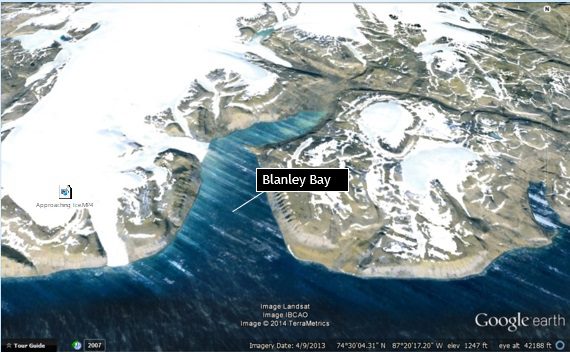
Reluctant to go back, we turned and began entering the bay. The winds were relatively light at about 10-15 knots out of the east, with seas less than one meter. The ice was about 20 percent, requiring us to pick our way through the leads. The ice pieces ranged in size from a meter across to as large as 25 meters. Given the wind, we headed for the east side of the bay, as that was the more open side. As we penetrated deeper in to the bay, our way was blocked by a line of small pieces of ice, narrow enough that it could be pushed gently out of the way. Before pushing through, however, the Forward Looking Sonar (FLS) probe that protrudes underneath the bow needed to be pulled out as a precaution, to prevent shearing it off. Pete and Dave went below to remove the probe. By the time I had made a wide circle with the boat, looking for the best place to cross, the ice was no longer the same. The thin line was now compacted. The ice had begun to move and passages between the floes where closing. With all hands on deck, we began to retreat, but the ice started to swirl and within a few minutes there was no place left to go, as islands of ice closed in around the hull.
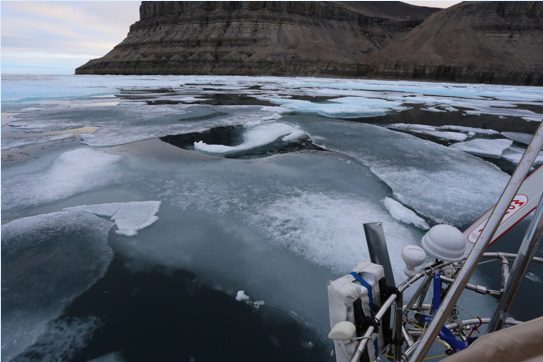
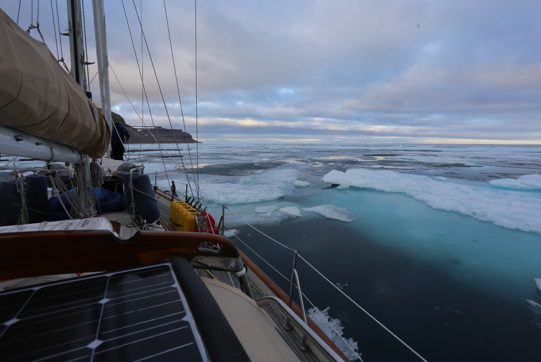
The immediate concern was for the boat. Even considering the worst, the crew felt no life-threatening danger given our zodiac, life raft, survival gear, and satellite communication with those who would offer help. But I felt sickened by the possibility that the ice could damage or breach the hull. As typical of human nature, it would be bad enough to lose the boat due to an “act of God,” but to lose her due to a mistake on my part would be heartbreaking. And here, due to inexperience and having misjudged the ice, she was in danger. Fortunately the Lillian B is a Baba 40 which is a very strongly designed vessel. I reminded myself that Suilven, also a fiberglass boat, had not been damaged after having been stuck in ice for over six hours. At the same time, I was fully aware that ice can carve mountains.
As the ice closed in, we began fending off with our ten foot boat hooks, discovering in the process that the boat could be moved forward. What started as a defensive maneuver quickly evolved into a concerted effort to get to open water, now a quarter of a mile away. The most anxious time came when trying to squeeze between two large floes. Lillian shuttered as she gently mounted the large ice to starboard. Directly below was an underwater shelf of turquoise blue ice, nearly incandescent in appearance. For several anxious seconds, we could neither go forward or backward. With measured use of the engine, and Dave and Pete shouting advice as they pushed hard with the boat hooks, Lillian slowly slide free and again began to inch forward.
Except for the fear of damaging the boat, moving through pack ice is exhilarating. The most effective approach is to identify the constantly evolving path of least resistance and then use the boat hooks, along with judicious engine power, to push or spin the floes in a direction they were willing to move. Trying to oppose the natural motion of the ice proves futile, as many of the pieces well outweighed the boat. As we did battle, Lillian moved incrementally forward, in a slow motion ballet of ice and boat. After two hours, she was into open water.
Elated to be free, we looked for a safe spot to hide. Leaving was no longer an option as, under strengthening winds, ice floes were streaming east to west across the mouth of the bay. Inside, along the eastern shore was a strip of open water in the lee of the cliffs. We searched for a spot close to the steep shore where the depth was shallow enough to have a chance of holding, and then dropped anchor. It was 2:00 am EDT, Aug. 4, 2014. For the next 30 hours we would deal with the winds and ice in Blanley. The ice seemed to move with a mind of its own, independent of wind and tide, as it circulated around the bay, necessitating repeatedly defending our position against the any maverick pieces headed our way. And, contrary to the weather predictions, the winds increased to over 30 knots from the east with gusts, repeatedly causing our anchor to come loose from the steep underwater slopes of loose shale. We took turns on watch and while in Blanley, re-anchored at least half a dozen times. As a crew, we did not get much sleep. Ironically, at some point during this marathon defensive effort, in talking to my wife on the satellite phone, she asked sincerely if I thought the adventure was worth it. The answer, which I have conveyed in a subsequent e-mail, is yes, but I’m not sure I sounded convincing at the time. At some point on Tuesday morning, Aug 5th another cluster of ice was bearing down on our position, but instead of moving to yet another spot in Blanley, we weighted anchor and bid the ice and Blanley Bay a not so polite good-bye.
As with our departure from Cuming, we were a half day out of phase with the ice charts. (Without internet connection, we are dependent on having these charts reduced in size and resolution and sent to us via satellite connection.) The last one still indicated that the harbors to the west, our desired direction of travel, had “green” ice, but the next report would not be available until later that afternoon. Given our recent experience, we took the conservative approach and began to retrace our steps towards Stratton in the east, knowing it had been open on Sunday. As we arrived, Dave announced cheerfully that the harbor was clear.
This time, it was Dave who would be shown to be prematurely optimistic, as halfway up the inlet, an impenetrable line of ice appeared out of the fog. There was no place to anchor. This discovery coincided with the download of the latest ice report. It said that Stratton and the harbors to the west were all clear. We knew this to inaccurate. We had just spent the afternoon visiting all possible harbors from Stratton to Blanley and none was open. But since we were not going to be anchored, we decided we might as well head back west. And, according to the reports, there was a chance that our original destination of Graham might be open.
Four hours later, as we were once again at the mouth of the now familiar Blanley Bay, 15 miles from Graham, the VHF radio came alive with the call “Lillian B, Lillian B, this is Manevai, over.” As exhausting as our last couple of days had been, we knew that the French boat Manevai had been battling ice for nearly a week in Blanley and nearby Maxwell Bay. They had seen our name and position on their chart plotter as transmitted by our shared Automated Information System (AIS). They were ten miles west of us and had spent the day in similar fashion, looking for an ice-free harbor. They had searched all the way west to Rigby, with no luck. They had also visited Graham and reported to us it was blocked. Not finding an open harbor, Manevai was going to back off the coast several miles and spend the night holding position at sea, inviting us to rendezvous with them using the AIS as a guide.
We discussed our options. I raised the possibility of returning to Blanley to which Dave gently suggested that the captain might end up adrift in the Zodiac if he were to try to take the crew back to Blanley. Not particularly wanting to return to Blanley as well, we adopted Pete’s suggestion to take a look at the entrance to Graham Harbour on the way to rendezvous with Manevai.
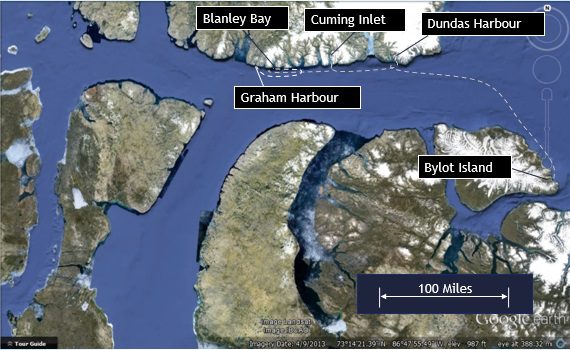
As we approached, there was ice outside, as they’d reported, although not quite as extensive as what we’d encountered at Blanley two days early. The wind and sea were dead calm. The air temperature at sea level was slightly above freezing, but the clear cold sky was generating a thin skin of ice on the water surface, like a film of cellophane stretching between the floes. Lillian gently cut through this crust as we motored in for a closer look. With gale winds in the forecast, a strong benefit of Graham was that the inner harbor was reported to be very well protected from both wind and ice. After a call to Manevai on the VHF to let them know our intentions, we pushed on, now acutely aware of how quickly conditions can change. With Dave at the helm, Pete on the bow looking forward, and me anxiously watching for any hint of that the ice was beginning to move, we threaded our way up to the narrow entrance to the inner harbor.
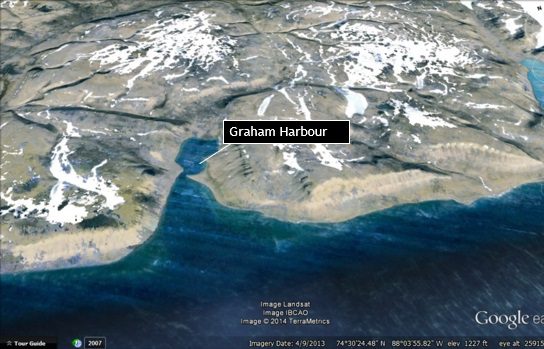
Using our sonar to guide us, we crossed the shallow threshold, entering into a mile wide basin, elated to see that there were only a few pieces of ice and ample room to maneuver. We picked a spot unthreatened by ice and set the anchor. It was 2:30 in the morning.
An attempt to call Manevai on the VHF to let them know the harbor was accessible failed, blocked by the high cliffs surrounding the anchorage. Hoping that they would not have a rough evening offshore, we went below, closed up the boat, and slept until noon.